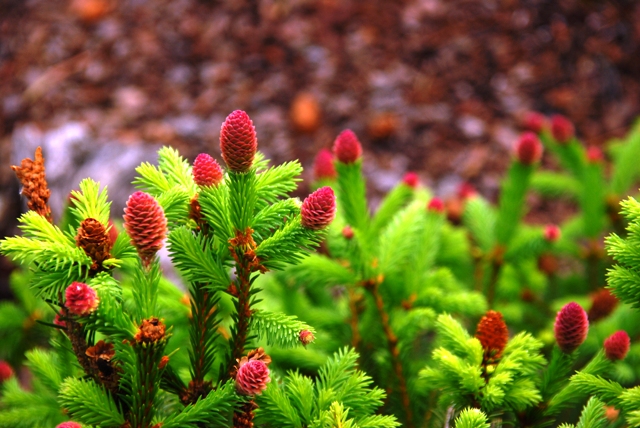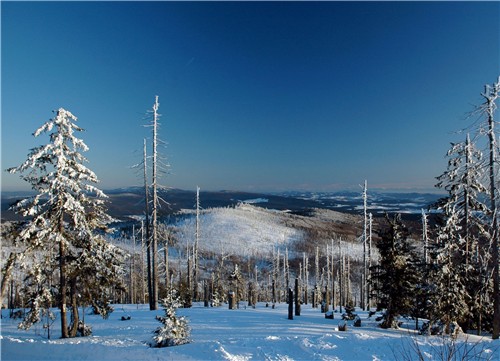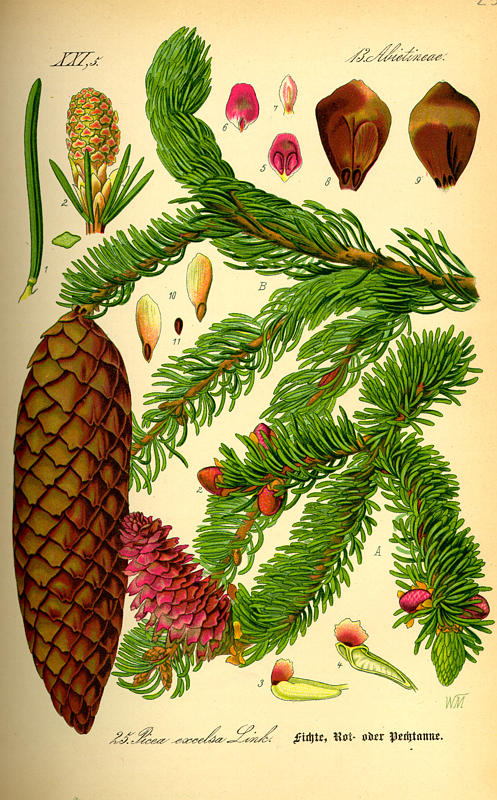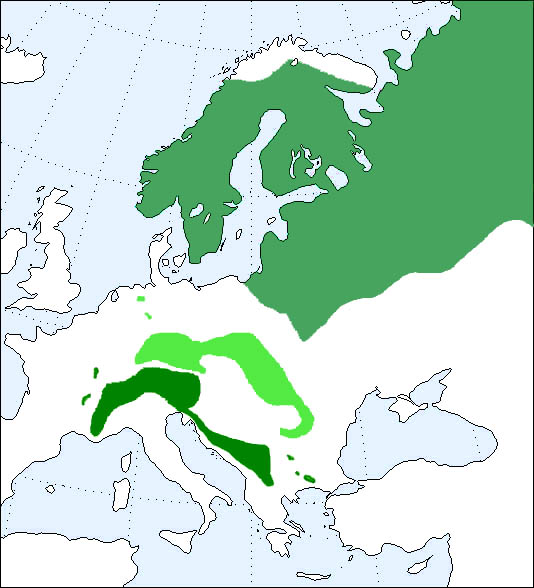My personal search for The Truth About Spruce has been ongoing for many years, but took a turn when someone insisted that Picea abies and Picea excelsa were two names for the same species. I had always understood they were separate, as the woods associated with the two names were certainly (I thought) quite different. I got busy with the web, some books and spoke at length with a couple of experts. I gained a better idea of what's what now with European spruce, and here's what I found out. First of all, the guy
who lumped them together was right and I was out
of date. In terms of the lutherie world, or for that
matter the world of plant biology, there is but one
species of spruce—used for lutherie—in all of
Europe: Picea abies. The map below shows the
three current European ranges of Picea abies,
a tree commonly known as Norway spruce in the US and Canada,
epicéa commun
in France, épinette de Norvège in Québec,
gemeinefichte
or rotefichte in German, and jel europeiskaya in
Russia. Other common
names abound, and the overriding one, in many
languages, is the translated local
equivalent of red spruce. Here is one reason it's known as red spruce:  Here's a map of the range of Picea abies:
As with most spruces, these trees naturally and historically live in cooler, higher elevations, preferring lots of moisture and rich, somewhat acidic soils. The original range includes most of Europe outside permafrost from the Scandinavian arctic down to northern Greece, west to the French Massif Central. The northern range extends off the map towards the Urals where it meets and hybridizes with Picea obovata. P. abies has been planted all over the planet by now, and adapts to a wide variety of soils and climates probably because it survived the Ice Age. The largest known example of one is in a park just west of Moscow, though this is an anomaly, since these trees typically don't live longer than about 200 years. Tiny remnants of the pre-glacier and pre-human-impact older range are found in the Pyrenees, down the center of Italy, and along the south coast of the Black Sea, in northern Turkey. The most southerly of the three ranges in this map (darkest green) lies in France, Switzerland, Italy and a bit of Austria and Slovenia - in other words, the south face of the Alps - trailing down through the mountainous parts of Bosnia, Herzegovina, Serbia and Montenegro, with remnants in Bulgaria and the Balkans. This is the part of the historical range that escaped glaciation and provided the reservoir for the reintroduction of the species back into the northern ranges after the glaciers retreated. The spruces of the lower range were, until recently, taxonomically classified as Picea excelsa. Many sources still refer to that as a species, while some refer to it as the German botanical designation for Picea abies. In any case, Picea excelsa has now been folded together with Picea abies as a single species. If you see the term Picea excelsa, it'll be in—or referenced to—older literature. The trees in the lower range are also still classified by some botanists as a subspecies called Picea abies v.excelsa. It is debatable if this is a wise designation, as the only thing distinguishing this so-called subspecies is how it grows in that environment. A propos, this is the range from which the Cremonese master violinmakers and the lutherie elite of Europe has historically gotten their wood. The white band separating the two lower ranges in the map above marks the high elevations of the Alps where icebergs try to grow, while the larger blank area east of there is the lowlands of Hungary and so on. The middle light-green range on the north slope of the Alps and across southern Germany and east into Poland and Czechoslovakia contains Picea abies, most of which has been reintroduced since 1800. Because of the thorough exploitation and devastation of the forests through the end of the 18th century and the enormous timber demand in early industrial times, the natural forests, which had already regrown after the retreat of the glaciers, were eliminated and eventually reborn as artificial forests. Ironically, the seed stock for the reintroduced Picea abies came from the relatively unscathed Scandinavian range (gray-green) at the top of the map, which had re-established itself from that southern reservoir after the last Ice Age.
It is an irony that over the last
fifty years or so, forest
management in Germany has increased forest size
considerably (in stark
contrast to the rest of the world) but its air
pollution is so extreme
(largely blowing in from other countries) that the
forests are very unhealthy
and the yield from that acreage is decreasing. Picea
abies is acutely vulnerable
to the pollution problems, notably acid rain. These
photos are from the Alps in Bavaria:

More information about acid rain here. Moreover, if you have
ever spent time talking wood with instrument makers
in Germany, they will chuckle and tell you they
consider "German spruce"
not just a misnomer but an unlikelihood. They
generally get their spruce
from farther south, in Italy, Slovenia, Switzerland
or France. This has
always been the source of the best lutherie spruce.
As Horst Grünert,
a bass and cello maker in Penzberg, Bavaria, once
cheerfully told me, he'd
go right out with his chainsaw and get the rare
spruce in Germany if he could
find it, but he said that for all intents and
purposes, it had been extinct
in Germany for several centuries (again, see below).
The spruce I was seeing
all over the Alps was, he said, good for fence posts
and pulp, and that's
what it was farmed for. Outside of parks and so on,
I never saw trees larger
than about eight inches either. That's them in the
above three photos. I know of only one wood cutter
inside the German border, high in the Alps close to Switzerland, who
harvests and mills spruce for lutherie. In conclusion, believe this:

Sidebar: Intercontinental trade in forest seed was established in the early 1700s, when seed of several eastern American species (yellow locust being a big one) were frequently shipped to Europe, mainly for use in ornamental plantations. Regular forest plantations of Picea glauca (white spruce), Pinus strobus (eastern white pine), and a few other American conifers, however, also began to be cultivated in Europe shortly after 1700. The first seed samples of northwestern American species, including Douglas fir and Sitka spruce, were sent to Europe about 1825 by the famous botanical explorer, David Douglas. Trade on a substantial scale in these species, however, did not begin until after the opening of the Pacific Railroad in 1869. The center of the trade in those days was San Francisco, where seed from the northwest was shipped by boat and thence east by train to dealers on the Atlantic coast, or direct to customers in Europe. Darmstadt in Germany was the other end of the pipeline in this trade. Bearing in mind that Picea
glauca was introduced into Europe about 1700
from America and mainly used in shelterbelt
plantings, it may be mentioned,
merely as a curious fact, that seed of this species
has been exported in
considerable quantities from Europe (Denmark) to
Canada during the last
decades. Even seed of such American species as Sitka
spruce and western
red cedar (both, however, of selected origin) have
recently been exported
from Denmark to American dealers. This is indeed an
improved forest seed
version of "carrying coals to Newcastle."
Unless you cut the tree
yourself or can be absolutely certain where
that tree was harvested, it is probably safest to
just call it spruce.
If you're certain it grew and was harvested in
Europe, there's no point
in getting your turban in a twist over common names.
If someone says
German spruce, just think, "OK, Picea abies,
or European
spruce."  I think to discern any differences between, say, Italian and Swedish and French spruce, you need only look to some analogs in the local (North American) spruces, because so many examples lie before us, a record that is huge and fresh. Just consider the staggering output of the big guitarmaking concerns like Martin, Gibson, and Taylor, not to mention folks like SCGC, Bourgeois, Collings and so on. What a consistent and generous resource for the rest of us, just to examine and evaluate their results. For starters, many thousands of guitars by these major makers are made from Sitka that grew in British Columbia, or Oregon, or other places. Can anyone tell them apart? By the same token, is Engelmann from New Mexico reliably discernible from Engelmann from Canada? Can anyone tell them apart after they've been made into guitars? Continuing in guitar-brain,
here’s another angle. Since the enormous output
centers largely on a
few basic models (dreadnought, OM, etc.), we can
safely consider and compare
a very large number of guitars made of different
species of spruce. Is
any one of them distinct tonally? No, not really.
We all know that some
guitars made from [ x ] species are terrific, some
are blah, regardless
of age or species. Can anyone tell them apart
visually? Of course not, it's simply not possible.
Any spruce
is capable of looking exactly like any other,
because spruce, being wood after all, is not a homogeneous
substance at all. Picea abies from
Jugoslavia is usually identical in appearance
to Picea rubens from the Adirondacks and Picea
engelmannii from northern
Idaho. Even Sitka, which some folks fervently
believe is very distinguishable,
can mimic other species, and conversely, the dark
lines that supposed to
be so telltale in Sitka show up in lots of Alpine
spruce too. The only
way to be certain of a spruce species is one of the following: 1) key the living tree and harvest it yourself 2) have a trained
scientist with a high powered microscope, a
library
of appropriate reference samples and a lot of skill
and experience, give
it a serious lab analysis. And realize that there's
even some question
about the absolute reliability of this method—the
best there
is—because the reference sample libraries are not
always complete and
comprehensive. Other than that you are operating on pure faith in the seller, or on pure imagination, because things are quite often not what they seem. Back to my earlier point, and about provenance: Engelmann comes from British Columbia and it also comes from New Mexico. That's as big a geographic spread as Sweden and Italy. Sitka comes from Alaska and from northern California—same thing. Adirondack comes from Georgia and from Québec—same thing. Is there any reliable coherence within species? Don't bet on it. We know them all, we see many examples of their applications, and that experience, we fervently hope, informs us. But not based on a handful of anecdotes. And that's following the notion that location means anything definitive I'm really not sure it does, except in a general sense. There's good and bad spruce from any location, any species. We all know this. Species and/or location is interesting chatter, but can be a waste of time too. Being able to listen to and hear a
promising piece of wood, and knowing how to bring
out its potential, is what it is really all
about.
|


 Today,
Picea abies comprises 35% of the tree cover
in Germany, and most of that
is in managed forests. Among the other major
conifers in German forests
are Picea glauca, an American import, and
Douglas fir, another American
import. These trees have been grown successfully in Germany for a
very long time (see
below).
Today,
Picea abies comprises 35% of the tree cover
in Germany, and most of that
is in managed forests. Among the other major
conifers in German forests
are Picea glauca, an American import, and
Douglas fir, another American
import. These trees have been grown successfully in Germany for a
very long time (see
below). 


